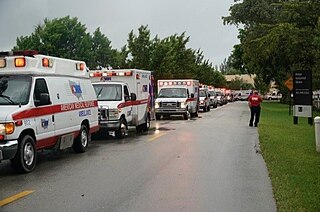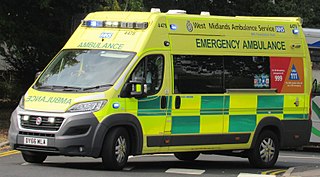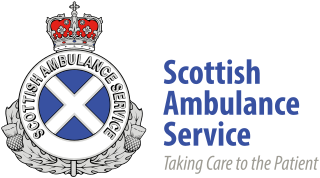
Emergency medical services (EMS), also known as ambulance services or paramedic services, are emergency services that provide urgent pre-hospital treatment and stabilisation for serious illness and injuries and transport to definitive care. They may also be known as a first aid squad, FAST squad, emergency squad, ambulance squad, ambulance corps, life squad or by other initialisms such as EMAS or EMARS.

An ambulance is a medically equipped vehicle which transports patients to treatment facilities, such as hospitals. Typically, out-of-hospital medical care is provided to the patient.

A certified first responder is a person who has completed a course and received certification in providing pre-hospital care for medical emergencies. Certified individuals should have received much more instruction than someone who is trained in basic first aid and cardiopulmonary resuscitation (CPR) but they are not necessarily a substitute for more advanced emergency medical care rendered by emergency medical technicians (EMTs) and paramedics. First responders typically provide advanced first aid level care, CPR, and automated external defibrillator (AED) usage. The term "certified first responder" is not to be confused with "first responder", which is a generic term referring to the first medically trained responder to arrive on scene and medically trained telecommunication operators who provide pre-arrival medical instructions as trained Emergency Medical Dispatchers (EMD). Many police officers and firefighters are required to receive training as certified first responders. Advanced medical care is typically provided by EMS, although some police officers and firefighters also train to become emergency medical technicians or paramedics.

A first responder is a person with specialized training who is among the first to arrive and provide assistance at the scene of an emergency, such as an accident, natural disaster, or terrorism. First responders typically include law enforcement officers, paramedics, EMT's and firefighters. In some areas, emergency department personnel, such as nurses and doctors, are also required to respond to disasters and critical situations, designating them first responders.

An emergency vehicle is a vehicle that is used by emergency services to respond to an incident. These vehicles are usually operated by designated agencies which are often part of the government, but also may be non-governmental organizations and commercial companies specifically authorised by law. Emergency vehicles may be exempted from some conventional road rules in order to reach their destinations in the fastest possible time, such as driving through an intersection when the traffic light is red, or exceeding the speed limit. In some states of the United States, however, the driver of an emergency vehicle can still be sued if the driver shows "reckless disregard for the safety of others."

The Hong Kong Fire Services Department is an emergency service responsible for firefighting and rescue on land and sea. It also provides an emergency ambulance service for the sick and the injured and gives fire protection advice to the public. It is under the Secretary for Security who heads the Security Bureau.

The London Ambulance Service NHS Trust (LAS) is an NHS trust responsible for operating ambulances and answering and responding to urgent and emergency medical situations within the London region of England. The service responds to 999 phone calls across the region, and 111 phone calls from certain parts, providing triage and advice to enable an appropriate level of response.

A nontransporting EMS vehicle, also known as a fly-car, response vehicle, or fast response vehicle, is a vehicle that responds to and provides emergency medical services (EMS) without the ability to transport patients. For patients whose condition requires transport, an ambulance is necessary. In some cases they may fulfill other duties when not participating in EMS operations, such as policing or fire suppression.

NSW Ambulance, officially the Ambulance Service of NSW, is an agency of NSW Health and the statutory provider of pre-hospital emergency care and ambulance services in the state of New South Wales, Australia.

The Scottish Ambulance Service is part of NHS Scotland, which serves all of Scotland's population. The Scottish Ambulance Service is governed by a special health board and is funded directly by the Health and Social Care Directorates of the Scottish Government.

Devon and Somerset Fire and Rescue Service (DSFRS) is the statutory fire and rescue service covering the county of Devon and the non-metropolitan county of Somerset in South West England – an area of 3,924 square miles (10,160 km2). The service does not cover the unitary authorities of North Somerset and Bath and North East Somerset, which are covered by the Avon Fire and Rescue Service. It serves a population of 1.75 million, and is the fifth largest fire and rescue service in the United Kingdom.

Essex County Fire and Rescue Service (ECFRS) is the statutory fire and rescue service for the county of Essex in the east of England, and is one of the largest fire services in the country, covering an area of 1,338 square miles (3,470 km2) and a population of over 1.7 million people.

The Gloucestershire Fire and Rescue Service is the statutory emergency fire and rescue service for the non-metropolitan county of Gloucestershire, England. The service is run by Gloucestershire County Council. The service does not cover the unitary authority of South Gloucestershire which is covered by Avon Fire and Rescue Service.

Emergency medical services in France are provided by a mix of organizations under public health control. The central organizations that provide these services are known as a SAMU, which stands for Service d'Aide Médicale Urgente. Local SAMU organisations operate the control rooms that answer emergency calls and dispatch medical responders. They also operate the SMUR, which refers to the ambulances and response vehicles that provide advanced medical care. Other ambulances and response vehicles are provided by the fire services and private ambulance services.

Emergency medical services in the United Kingdom provide emergency care to people with acute illness or injury and are predominantly provided free at the point of use by the four National Health Services (NHS) of England, Scotland, Wales, and Northern Ireland. Emergency care including ambulance and emergency department treatment is only free to UK residents and a charge may be made to those not entitled to free NHS care. The NHS commissions most emergency medical services through the 14 NHS organisations with ambulance responsibility across the UK.

Cleveland Fire Brigade is the statutory fire and rescue service covering the boroughs of Hartlepool, Middlesbrough, Redcar and Cleveland & Stockton-on-Tees in the North East of England. The name originates from the former county of Cleveland which was abolished in 1996. The brigade’s area is split between the ceremonial counties of County Durham and North Yorkshire.

Cornwall Fire and Rescue Service is the statutory fire and rescue service covering Cornwall, England. As of April 2019, the service employs over 400 retained firefighters, 203 full-time firefighters, plus 170 support and administrative staff. Created under the Fire Services Act 1947 as "Cornwall Fire Brigade", the name changed to "Cornwall Fire and Rescue Service" on 1 October 2009.

Lincolnshire Fire and Rescue (LFR) is the statutory fire and rescue service serving the non-metropolitan county of Lincolnshire in the East Midlands Region of England. This does not include North Lincolnshire and North East Lincolnshire, which are covered by Humberside Fire and Rescue Service.
Emergency medical services in Australia are provided by state ambulance services, which are a division of each state or territorial government, and by St John Ambulance in both Western Australia and the Northern Territory.

Motorcycle ambulances are a type of emergency vehicle which either carries a solo paramedic or first responder to a patient; or is used with a trailer or sidecar for transporting patients. Because of its size and performance, a motorcycle ambulance is able to respond to a medical emergency much faster than a car, van, or fire truck in heavy traffic, which can increase survival rates for patients suffering cardiac arrest.



















